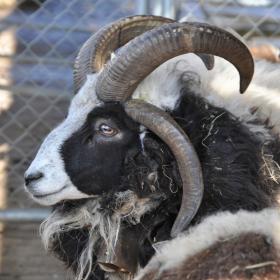Biodiversity Reading time 1 min
Mystery of four-horned goats and sheep finally solved
Published on 17 February 2021

Some members of the Bovidae family1 have additional horns. In fact, a few local breeds of sheep, which have been selected by many generations of breeders, are known for their multiple horns. Some goats may spontaneously develop an extra pair of horns as well, particularly in the Alps. Evidence of the existence of these animals, known as polycerate, goes back several centuries, for example, the transfer of a four-horned goat, from the town of Bulle in Switzerland to the Queen's farm in Versailles in 1786—requested by Queen Marie-Antoinette—is duly recorded. However, the genetic causes of this morphological anomaly remained unknown, until now.
By studying the genome of more than 2000 goats and sheep, researchers were able to solve the mystery. Their results reveal that polycerate individuals all carry a mutation affecting the same gene:
HOXD1. This is a homeotic gene, which means that it is involved in the organisation of the body plan during the development of embryos. Although the mutation observed in sheep and goats is different, in both cases, it leads to a reduction in the amount of the HOXD1 protein produced by the gene of the same name.
Researchers were able to determine that the function of the HOXD1 gene is to delimit the region where horns can grow on either side of the animal’s head. When a gene mutation occurs, the surface expands, resulting in the splitting of the horn buds during embryonic development and, as a result, the growth of supernumerary horns. This is a new and unexpected function for a homeotic gene, a function that probably evolved specifically with the appearance of bovids, and which makes it possible to determine the precise area where these distinctive organs will emerge, as well as their number.
1 A family of cloven-hoofed ruminant mammals including cows, sheep and goats.
|
Reference Allais-Bonnet, A, Hintermann, A et al. (2021) Analysis of Polycerate Mutants Reveals the Evolutionary Co-option of HOXD1 for Horn Patterning in Bovidae, Molecular Biology and Evolution, msab021, |

|

|
